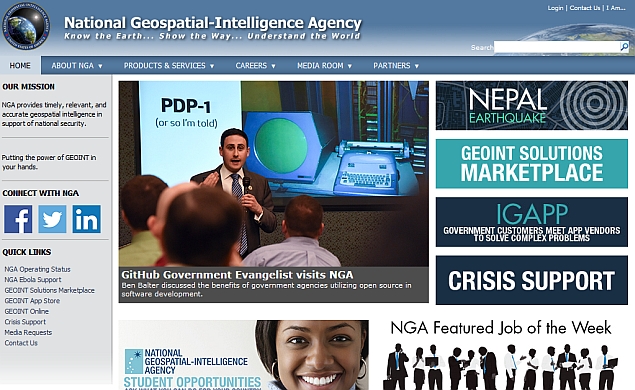- Home
- Internet
- Internet News
- US National Geospatial Intelligence Agency: Opening Up to a Changing World
US National Geospatial-Intelligence Agency: Opening Up to a Changing World

Much about the National Geospatial-Intelligence Agency remains classified, but the U.S. spy agency that maps and analyzes the earth is opening up more than ever, from sharing computer source code on a public website to tapping new sources of intelligence.
The NGA's director, Robert Cardillo, is leading what he calls a "seismic shift" in the agency's culture to help it better exploit social media, commercially available imagery and other data to continue providing high-level intelligence to the U.S. government.
The NGA this week opened its doors to GitHub, the world's largest site for sharing source code, to advance another goal - to encourage its employees to share analytical tools and other computer programs and get feedback from other developers.
The NGA last year become the first U.S. spy agency to set up its own page on GitHub, but other agencies are following suit. The National Security Agency's page premiered this week, and the Defense Intelligence Agency plans to set up its page soon.
This summer, the NGA will also participate in Google Inc's high-profile "Summer of Code" for young developers.
"Posting code to open source forums allows the private sector and others to examine the agency's research up close, and potentially benefit from it through additional enhancements and applications. At the same time, the government can gain from related research advances," said NSA spokeswoman Vanee Vines.
GitHub's "government evangelist" Ben Balter told workers at the NGA's headquarters in Springfield, Va. that no one expected them to publish their "special sauce," but said they could benefit by sharing more routine tools.
Sharing code allows agencies to benefit from work done by other developers, saving funds for harder challenges, he said.
He said the GeoQ disaster response software posted by the NGA last year was a huge hit, and had already been adopted by the Federal Emergency Management Agency and other agencies.
In August, the NGA will kick off a new program called GEOINT Pathfinder that will test the agency's ability to answer four key intelligence questions using only publicly available data, social media, and commercial information technology.
The questions, like the NGA's budget, remain classified.
The agency's shift is being driven by the spread of smart phones, social media and the rapid spread of commercial satellite imager - all developments that are generating huge amounts of data that was once available only to governments. Tighter budgets also play a role.
"As the world is opening up, intelligence doesn't necessarily always equal secrecy," said Chris Rasmussen, who heads the Pathfinder program for the NGA. "It's a question of relevance and niche ... Most of agency's value proposition going forward will come from unclassified sources."
The NGA's ultimate goal is to answer the bulk of U.S. intelligence questions through open sources, while reserving its most exquisite and expensive satellites and other resources for tough questions that cannot be answered any other way, he said.
DigitalGlobe Inc , which provides commercial imagery to the NGA and other customers, said it is building new tools to allow the agency and other parts of the government to use public data to make better use of its high-resolution imagery.
Tony Frazier, senior vice president at DigitalGlobe, said the company also posted to GitHub a tool called MrGeo that it developed under the NGA's research and development budget.
© Thomson Reuters 2015
Catch the latest from the Consumer Electronics Show on Gadgets 360, at our CES 2026 hub.
Related Stories
- Samsung Galaxy Unpacked 2025
- ChatGPT
- Redmi Note 14 Pro+
- iPhone 16
- Apple Vision Pro
- Oneplus 12
- OnePlus Nord CE 3 Lite 5G
- iPhone 13
- Xiaomi 14 Pro
- Oppo Find N3
- Tecno Spark Go (2023)
- Realme V30
- Best Phones Under 25000
- Samsung Galaxy S24 Series
- Cryptocurrency
- iQoo 12
- Samsung Galaxy S24 Ultra
- Giottus
- Samsung Galaxy Z Flip 5
- Apple 'Scary Fast'
- Housefull 5
- GoPro Hero 12 Black Review
- Invincible Season 2
- JioGlass
- HD Ready TV
- Laptop Under 50000
- Smartwatch Under 10000
- Latest Mobile Phones
- Compare Phones
- OPPO Reno 15 Pro Max
- Honor Win RT
- Honor Win
- Xiaomi 17 Ultra Leica Edition
- Xiaomi 17 Ultra
- Huawei Nova 15
- Huawei Nova 15 Pro
- Huawei Nova 15 Ultra
- Asus ProArt P16
- MacBook Pro 14-inch (M5, 2025)
- OPPO Pad Air 5
- Huawei MatePad 11.5 (2026)
- Xiaomi Watch 5
- Huawei Watch 10th Anniversary Edition
- Acerpure Nitro Z Series 100-inch QLED TV
- Samsung 43 Inch LED Ultra HD (4K) Smart TV (UA43UE81AFULXL)
- Asus ROG Ally
- Nintendo Switch Lite
- Haier 1.6 Ton 5 Star Inverter Split AC (HSU19G-MZAID5BN-INV)
- Haier 1.6 Ton 5 Star Inverter Split AC (HSU19G-MZAIM5BN-INV)

















